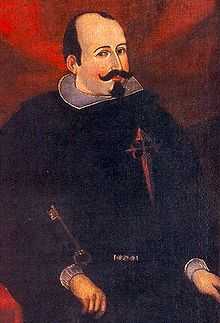Luis Jerónimo de Cabrera, 4th Count of Chinchón

Luis Jerónimo Fernández de Cabrera Bobadilla Cerda y Mendoza, 4th Count of Chinchón (1589 in Madrid – October 28, 1647 in Madrid) was a Spanish nobleman and captain general and Viceroy of Peru, from January 14, 1629 to December 18, 1639. His wife, Ana de Osorio (1599–1625), is credited as being one of the first Europeans to be treated with quinine, and as the person who introduced that medicine into Europe.
Birth
Fernández de Cabrera Bobadilla was born in Madrid in 1589 (or perhaps 1590), into a family close to the Spanish throne. His parents were Diego Fernández de Cabrera, third Count of Chinchón and Inés Pacheco, the daughter of the marquis of Villena and 3rd Duke of Escalona, Diego López Pacheco, and Luisa Bernarda de Cabrera Bobadilla, third marquesa of Moya. Don Luis's parents were first cousins.
Viceroy of Peru
He became viceroy of Peru in 1629. During his government, he suppressed an insurrection of the Uru and Araucano Indians. He also sent out the third expedition to explore the Amazon River, under Cristóbal de Acuña. (It was part of the return leg of the expedition of Pedro Teixeira.) He expanded the colonial navy and fortified the port of Callao.
Among his other official acts were the prohibition of direct trade between Peru and New Spain (Mexico) and the persecution of Portuguese Jews, the principal traders in Lima.
He also founded two chairs of medicine in the University of San Marcos.
Quinine
In an account published in 1663 by Sebastiano Bado, an Italian, the following claim was made: In 1638, the Countess of Chinchon became severely ill with tertian fever (malaria). Juan López de Canizares, governor of Loxa, wrote the viceroy, explaining that he had recently been cured by the bark of the quinaquina tree, and recommending the same remedy to the vicereine. The governor was summoned to Lima, the medicine was administered, and the countess was cured. In 1639, according to Bado, the countess returned to Spain, bringing a large quantity of the bark with her. This was the first introduction of quinine into Europe.
However, the official diary of Viceroy Fernández de Cabrera was discovered in 1930. This diary contradicts many of the claims made by Bado. It states that Ana de Osorio, his first countess of Chinchón, died in Spain at least three years before her husband was named viceroy of Peru. It was his second countess, Francisca Henríquez de Ribera, who accompanied the Count to South America, where she enjoyed excellent health. The count himself had several episodes of fever, but was never treated with bark. Neither did the second countess ever returned to Spain; she died in the port of Cartagena, Colombia during the return voyage.
In light of these much later revelations, Bado's account is now discredited among historians. Jesuit Barnabé de Cobo (1582–1657), who explored Mexico and Peru, is now credited with taking cinchona bark to Europe. He brought the bark from Lima to Spain, and afterwards to Rome and other parts of Italy, in 1632.
Carolus Linnaeus called the genus of quinine-producing trees Cinchona in honor of the countess.
See also Jesuit's bark.
Return to Spain
At the conclusion of his term as viceroy in 1639, Fernández de Cabrera returned to Spain, where he became a counselor of state and accompanied King Philip IV of Spain on campaign in Navarre, Aragon and Valencia. He died in 1647 in Madrid.
External links
- His article in The Columbia Encyclopedia, Sixth Edition. Copyright © 2001-05 Columbia University Press.
- (Spanish) Microsoft Encarta (Archived 2009-11-01) encyclopedia
- Introduction of quinine into Europe
| Government offices | ||
|---|---|---|
| Preceded by The Marquis of Guadalcázar |
Viceroy of Peru 1629–1639 |
Succeeded by The Marquis of Mancera |
| Spanish nobility | ||
| Preceded by Diego Fernández de Cabrera |
Count of Chinchón 1623–1647 |
Succeeded by Francisco Fernández de Cabrera |